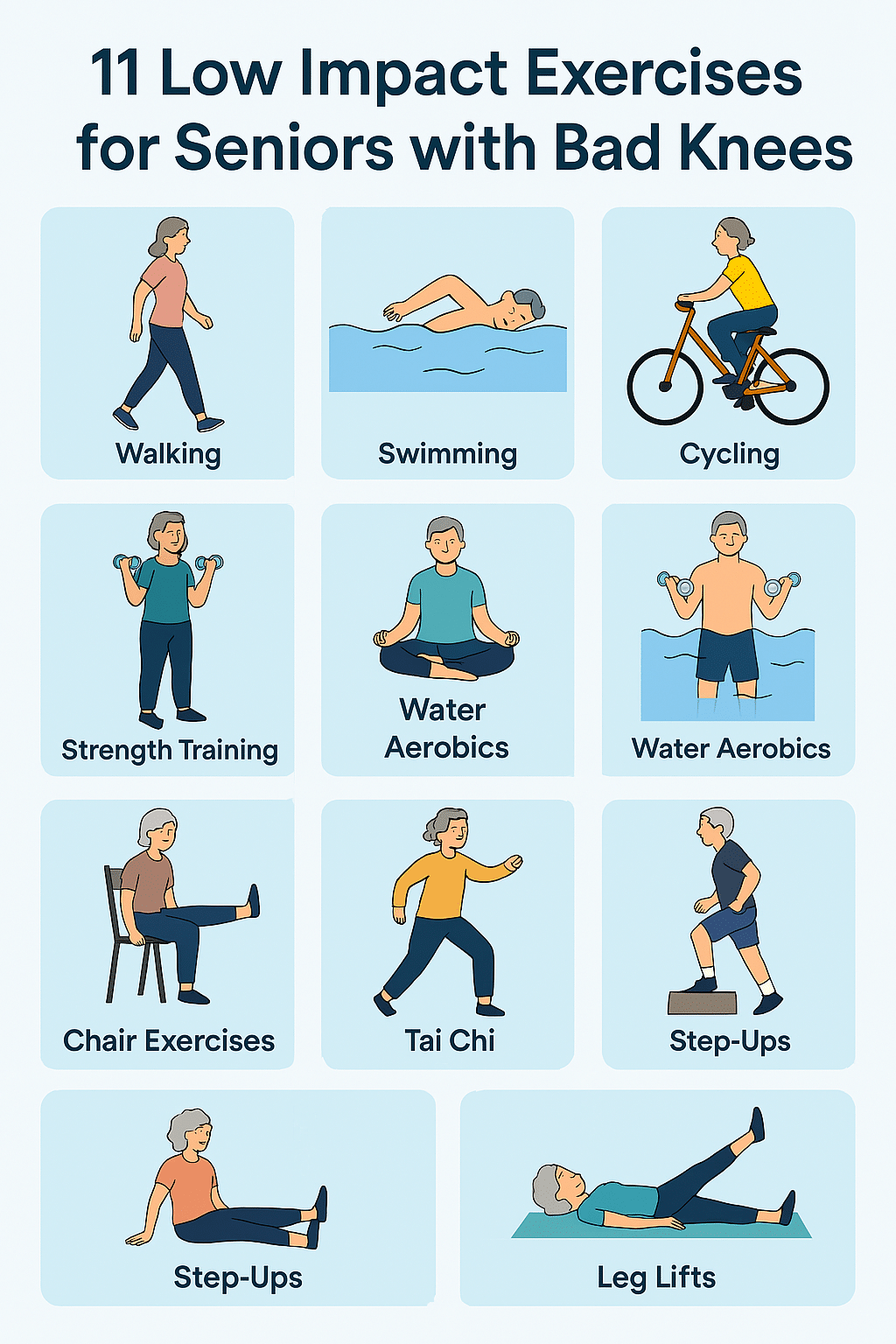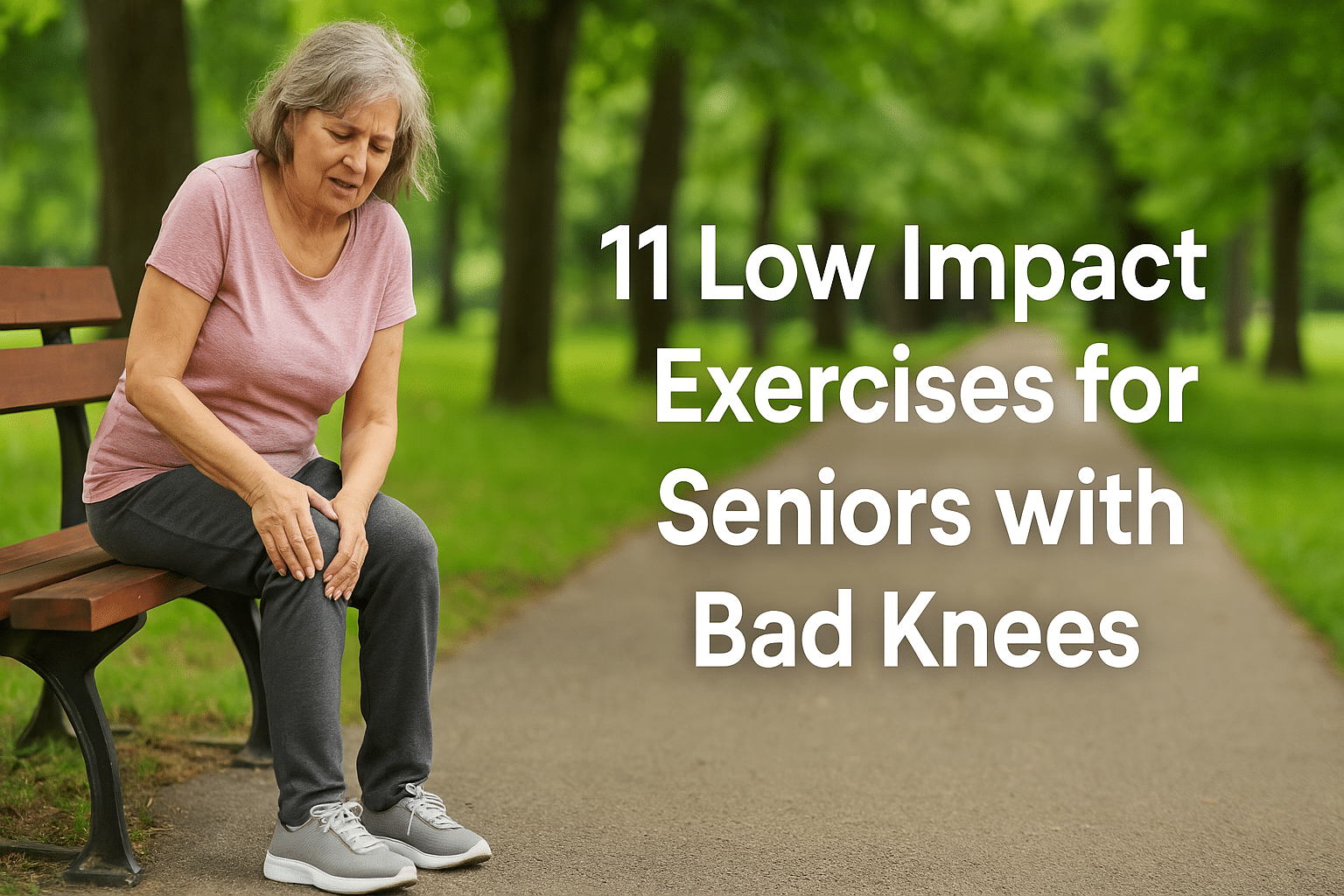Are your achy knees stopping you from staying active? You’re not alone. I’ve helped countless seniors find ways to keep moving without the pain.
The good news? You don’t need high-impact workouts to stay fit. Low impact exercises can actually strengthen the muscles around your knees while protecting your joints from further damage.
In this guide, I’ll share 11 effective, gentle exercises specifically designed for seniors with knee pain. These movements will help you maintain mobility, build strength, and reduce discomfort – all without putting stress on those sensitive joints.
Table of Contents

Why Low Impact Exercise Is Important for Seniors with Knee Pain
As we age, our joints naturally experience wear and tear. For many of us, knee pain becomes an unwelcome companion, often from conditions like osteoarthritis where the protective cartilage cushioning our joints begins to deteriorate.
Walking, water aerobics, cycling, swimming, yoga, and strength training can all help improve symptoms associated with arthritic knee pain and knee pain in general. These activities share one important quality – they’re gentle on your joints while still providing effective workout benefits.
Regular low impact exercise helps:
- Strengthen muscles surrounding the knee joint
- Improve joint stability and flexibility
- Reduce inflammation and pain
- Maintain healthy weight (which reduces pressure on knees)
- Enhance overall mobility and independence
Unlike high-impact activities (running, jumping, basketball), low impact workouts don’t stress your already sensitive knee joints. This makes them ideal for joint-friendly movements that keep you active without causing flare-ups.
How to Exercise Safely with Bad Knees
Before diving into any new exercise routine, safety should be your top priority. Here’s how to protect your knees while working out:
Start with a proper warm-up
Always begin with 5-10 minutes of gentle movement to increase blood flow to your muscles and joints. Try marching in place slowly or seated arm circles to prepare your body.
Listen to your body
If you notice that pain is worse when exercising, you might need to adjust your exercise plan. An expert can help you find ways to exercise with less discomfort. Some mild discomfort during movement is normal, but sharp or severe pain means stop immediately.
Maintain proper form
Incorrect positioning can place additional stress on your knees. When doing standing exercises, keep knees aligned with your toes (never let them collapse inward).
Use supportive equipment
Wear shoes with good cushioning and consider using a chair or wall for balance support. Some people benefit from knee braces during activity.
Stay consistent but don’t overdo it
Aim for regular, shorter sessions rather than occasional intense workouts. Even 10-15 minutes daily is beneficial.
Consult healthcare professionals
Talk to your doctor or physical therapist before starting a new exercise program, especially if you have severe knee pain or recent injuries.
11 Low Impact Exercises for Seniors with Bad Knees
1. Seated Leg Raises
Sit in a chair with your back straight and both feet flat on the floor. Raise your left foot off the floor while keeping your back straight and your upper body still. Extend your left leg out in front of you. Hold your leg in the outstretched position for 1 second. Slowly lower your foot back onto the floor. Repeat 10 times with each leg.
Why it’s good: This exercise strengthens your quadriceps (front thigh muscles) which support your knees during daily activities like standing up from a chair or climbing stairs.
2. Water Walking or Aqua Jogging
Water exercises can be beneficial for bad knees. Swimming and aerobics done in the water takes the weight off weakened or aching knees due to water’s buoyancy, making it easier to engage in physical activity.
Why it’s good: The water supports your body weight, reducing impact on painful joints while providing natural resistance to build strength.
3. Chair Yoga
Simple yoga poses modified to be done while seated can improve flexibility and joint mobility. Try gentle twists, forward bends, and ankle rotations from a secure chair.
Why it’s good: Chair yoga improves range of motion without putting pressure on your knees, and helps with balance and stress reduction.
4. Wall Push-Ups
Stand facing a wall, place your hands on the wall at shoulder height. Keep your feet shoulder-width apart and slowly bend your elbows to bring your chest toward the wall, then push back to starting position.
Why it’s good: This exercise strengthens your upper body without any strain on your knees, improving overall functional strength.
5. Standing March in Place
Hold onto a chair or counter for support. Slowly lift one knee up to hip level (or as high as comfortable), then lower and repeat with the other leg. Keep movements controlled.
Why it’s good: Marching in place is a good way to help your hip flexibility and overall balance. It also provides gentle cardio benefits.
6. Resistance Band Arm Workouts
Sit in a sturdy chair and use a resistance band for upper body exercises like bicep curls, shoulder presses, and chest presses.
Why it’s good: These exercises improve upper body strength without putting any stress on your knees, helping with daily activities like carrying groceries.
7. Step Touch Side to Side
Stand with your feet approximately hip-width apart and let your arms hang at your sides. Lift your right foot and step to the right side. Bring your left foot to meet your right foot. Reposition your feet hip-width apart. Lift your left foot and step to the left side.
Why it’s good: This gentle movement improves lateral stability and hip strength, which helps protect your knees during daily activities.
8. Heel Slides
Lie on your back on a firm surface with one leg straight and the other bent. Slowly slide the heel of your bent leg away from your body until your leg is straight, then slide it back. Repeat with both legs.
Why it’s good: This exercise gently strengthens the muscles around your knee without applying pressure to the joint itself.
9. Tai Chi for Joint Mobility
Tai chi involves breathing techniques and meditation and can help maintain muscle strength, flexibility, and balance. This holistic approach may also benefit a person’s mental health.
Why it’s good: The slow, fluid movements improve joint mobility, balance, and coordination while being extremely gentle on your knees.
10. Stationary Recumbent Bike
Cycling is usually a lower impact exercise than walking or running. Recumbent bicycles provide even more support for the body, putting less weight and strain on the knees than traditional bicycles.
Why it’s good: The seated position with back support reduces knee strain while still providing effective cardiovascular exercise.
11. Standing Calf Raises
Start by standing on a flat surface. Make sure you have something to hold onto to support your balance, like the back of a chair or edge of a counter. Stand on your tiptoes, raising your heels off the ground. Hold for three counts, then slowly lower your heels to the floor. Repeat 10 times, up to three sets.
Why it’s good: Strong calf muscles help support your knees and improve overall leg stability.
Weekly Sample Routine for Seniors with Bad Knees
Here’s a simple 3-day routine to get you started:
Day 1 – Strength Focus (15-20 minutes)
- Seated Leg Raises: 2 sets of 10 reps per leg
- Wall Push-Ups: 2 sets of 8 reps
- Resistance Band Arm Workout: 8-10 reps of bicep curls and chest presses
- Heel Slides: 10 reps each leg
Day 2 – Flexibility Focus (15-20 minutes)
- Chair Yoga: 10 minutes of gentle seated poses
- Standing Calf Raises: 2 sets of 10 reps
- Tai Chi: 5-10 minutes of basic movements
Day 3 – Cardiovascular Focus (15-20 minutes)
- Stationary Recumbent Bike: 8-10 minutes at comfortable pace
- Water Walking (if available): 10 minutes
- Step Touch Side to Side: 2 sets of 10 reps
Remember to start with just 10-15 minutes and gradually build up as your strength and endurance improve.
Tips for Staying Consistent with Your Exercise Routine
Set a regular schedule
Pick specific days and times for your exercises and mark them on your calendar. Treat these appointments with yourself as non-negotiable.
Start small and build gradually
Begin with just 5-10 minutes daily, then add a minute each week. Small, consistent efforts lead to big results over time.
Find an exercise buddy
Whether it’s a friend, family member, or caregiver, having someone to exercise with makes it more enjoyable and helps with accountability.
Track your progress
Keep a simple journal noting how you feel after each session. Seeing improvements in how far you can move or how long you can exercise is motivating.
Make it enjoyable
Listen to your favorite music, podcast, or watch TV while exercising to make the time pass more quickly.
FInal Thoughts: Moving Forward with Confidence
Living with knee pain doesn’t mean giving up an active lifestyle. These 11 low impact exercises give you safe, effective options to stay mobile while protecting your joints.
Remember that consistency is more important than intensity. Even a few minutes of gentle movement each day can lead to significant improvements in strength, mobility, and pain levels over time.
Start where you are, use what support you need, and be patient with your progress. Your knees might be giving you trouble now, but with these joint-friendly exercises, you can take meaningful steps toward less pain and more freedom of movement.
Looking for more support? Consider discussing joint supplements with your doctor, investigating supportive footwear options, or asking about physical therapy for personalized guidance.
What knee-friendly exercise will you try first? Start small, stay consistent, and watch how your body responds with gratitude to this gentler approach to fitness.

Rick Huey is a fitness writer who has dedicated his life to living an active lifestyle. With more than 30 years of experience in the fitness industry, Rick is a respected contributor for FitFab50.com, where he shares his wealth of knowledge with a wide audience. His dedication to promoting the benefits of living an active lifestyle has inspired many people to pursue their own fitness journeys with enthusiasm and dedication.
